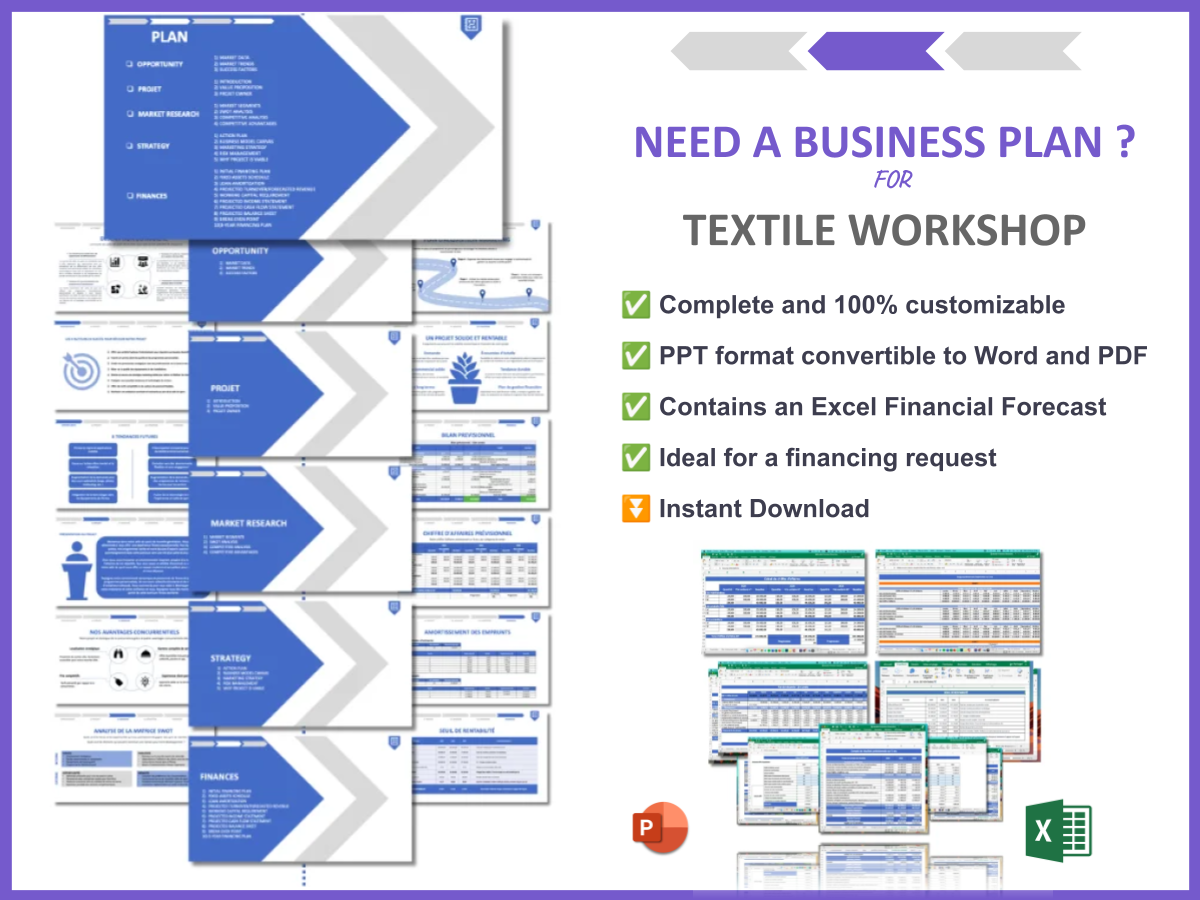Are you considering how to start a textile workshop? You’re not alone! The textile industry is booming, with a growing demand for unique and custom fabrics. In fact, the market for textiles is expected to reach over $1 trillion by the end of the decade. This article will guide you through the essential steps to establish a successful textile workshop, from defining your vision to marketing your products. Here’s what we’ll cover:
- Defining your vision and niche.
- Conducting thorough market research.
- Choosing a memorable name for your workshop.
- Crafting a detailed business plan.
- Determining the legal structure.
- Securing funding and resources.
1. Define Your Vision for Your Textile Workshop
Before you dive into the details of starting your textile workshop, it’s crucial to clarify your vision. What do you want to achieve? Are you looking to create high-quality custom garments, eco-friendly products, or perhaps innovative textile art?
Your vision will serve as the foundation for your business decisions and strategies. It’s like the North Star guiding you through the entrepreneurial journey.
Tip: Write a vision statement that encapsulates your goals and values. This will not only help you stay focused but also communicate your mission to potential customers and partners.
Here’s a simple framework to help you articulate your vision:
- What: What products or services will you offer?
- Who: Who is your target audience?
- Why: Why does your workshop exist? What problem does it solve?
2. Conduct Thorough Market Research for Your Textile Workshop
Now that you have a clear vision, the next step is to conduct thorough market research. Understanding the landscape of the textile industry is vital to your success.
Start by exploring the current textile industry trends. What are consumers looking for? Is there a growing interest in sustainable materials? Are there gaps in the market that you could fill?
Here’s a checklist to guide your market research:
- Identify your target audience: Who will buy your products? Consider demographics, preferences, and buying behavior.
- Analyze competitors: Research other textile workshops in your area or niche. What are their strengths and weaknesses? What can you learn from them?
- Look for market opportunities: Are there emerging trends or underserved segments? This could be your chance to innovate!
To help visualize your findings, create a simple SWOT analysis table:
| Strengths | Weaknesses |
|---|---|
| Your unique skills or offerings | Limited funding or resources |
| Opportunities | Threats |
| Growing market for eco-friendly textiles | High competition in the industry |
By conducting comprehensive market research, you’ll gain valuable insights that will inform your business strategy and help you position your textile workshop effectively in the marketplace.
3. Choose a Memorable Name for Your Textile Workshop
Your business name is your first impression, so it’s essential to make it memorable and relevant. A catchy name can help you stand out in the crowded textile market and resonate with your target audience.
When brainstorming names, consider the following:
- Relevance: Choose a name that reflects the essence of your textile workshop. It should hint at what you do or the values you stand for.
- Uniqueness: Ensure that your name is distinct. A unique name will help you avoid confusion with competitors and make it easier for customers to find you.
- Domain Availability: If you plan to have an online presence, check if the domain name is available. A matching website URL can enhance your brand identity.
Here’s a simple process to help you choose the perfect name:
- Brainstorm a list of potential names.
- Ask friends or family for feedback on your favorites.
- Check for trademark availability and domain names.
- Finalize your choice and register it.
Tip: Don’t rush this process. A well-thought-out name can have a lasting impact on your brand’s success.
4. Craft a Detailed Business Plan for Your Textile Workshop
Creating a robust business plan is a crucial step in starting your textile workshop. This document will serve as your roadmap, outlining your goals, strategies, and financial projections.
A well-structured business plan can also help you secure funding from investors or lenders. Here’s what to include:
- Executive Summary: A brief overview of your business, including your mission statement and key objectives.
- Market Analysis: Insights into the textile industry, target market, and competitive landscape.
- Organization and Management: Your business structure and the team involved in running the workshop.
- Products and Services: A detailed description of the textiles you plan to create.
- Marketing Strategy: How you will promote your textile workshop and attract customers.
- Financial Projections: Estimated income, expenses, and profitability over the next few years.
I recommend checking out this business plan template for Textile Workshop. It’s super detailed and can save you a ton of time!
Here’s a simple table to outline the key sections of your business plan:
| Section | Description |
|---|---|
| Executive Summary | Overview of your business goals and vision. |
| Market Analysis | Insights into industry trends and competitor analysis. |
| Financial Projections | Estimated income, expenses, and profitability. |
By crafting a detailed business plan, you’ll not only clarify your vision but also set a strong foundation for your textile workshop’s future.
5. Determine the Legal Structure for Your Textile Workshop
Choosing the right legal structure for your textile workshop is a critical step that can impact your taxes, liability, and operational flexibility. The main options include:
- Sole Proprietorship: This is the simplest form of business structure. You maintain complete control, but you’re also personally liable for any debts.
- Limited Liability Company (LLC): An LLC provides liability protection for your personal assets while allowing flexibility in management and taxation.
- Corporation: A more complex structure, a corporation is a separate legal entity. It offers liability protection but involves more regulatory requirements.
Considerations: Before making a decision, think about the following factors:
- Liability: How much personal risk are you willing to take?
- Tax Implications: Different structures have different tax obligations.
- Future Growth: Will your chosen structure allow for growth and scalability?
It’s advisable to consult with a legal expert to understand the implications of each structure based on your specific business goals and needs.
6. Secure Funding and Financial Resources for Your Textile Workshop
Securing adequate funding is essential to kickstart your textile workshop. You’ll need to cover startup costs such as equipment, materials, and marketing expenses. Here are some common funding sources to consider:
- Personal Savings: Using your own money can be a straightforward way to fund your workshop.
- Bank Loans: Traditional loans can provide significant funding, but they often require a solid business plan and credit history.
- Investors: Bringing in investors can provide capital in exchange for equity in your business.
- Crowdfunding: Platforms like Kickstarter or Indiegogo can help you raise funds by pre-selling your products or offering rewards.
Here’s a simple table to help you outline your estimated startup costs:
| Expense Category | Estimated Cost |
|---|---|
| Equipment (sewing machines, tools) | $5,000 |
| Initial Inventory (fabrics, threads) | $3,000 |
| Marketing (website, advertising) | $2,000 |
| Licenses and Permits | $500 |
| Miscellaneous Expenses | $1,000 |
By carefully evaluating your funding options and estimating your startup costs, you’ll be better prepared to launch your textile workshop successfully.
7. Register Your Business to Make Your Textile Workshop Official
Once you have secured funding and established your business plan, it’s time to make your textile workshop official by registering your business. This step is crucial for legal recognition and credibility.
Here’s a step-by-step guide to registering your business:
- Choose Your Business Name: Ensure it’s unique and not already in use.
- Register with State Authorities: Depending on your location, you may need to register with state or local government agencies.
- Obtain a Federal Employer Identification Number (EIN): This is necessary for tax purposes and can be obtained from the IRS.
- Check Local Regulations: Some areas may require additional permits or licenses specific to the textile industry.
Tip: Keep all your registration documents organized. This will help you when applying for loans or permits in the future.
8. Obtain Necessary Tax Identification Numbers, Licenses, and Permits for Your Textile Workshop
After registering your business, it’s essential to obtain the necessary tax identification numbers, licenses, and permits to operate legally. This ensures compliance with local, state, and federal regulations.
Here’s what you need to consider:
- Tax Identification Numbers: Apply for an EIN if you plan to hire employees or if your business structure requires it.
- Business Licenses: Depending on your state and local laws, you may need a general business license or specific licenses related to textiles.
- Health and Safety Permits: If you are using chemicals or heavy machinery, ensure you comply with health and safety regulations.
Here’s a checklist to help you stay on track:
- Research local licensing requirements for textile workshops.
- Gather necessary documentation (e.g., business registration, identification).
- Submit applications and pay any required fees.
Keeping your business compliant not only protects you legally but also builds trust with your customers. It’s a foundational step towards establishing a reputable textile workshop.
9. Set Up Your Financial Management Systems for Your Textile Workshop
Establishing a solid financial management system is crucial for the success of your textile workshop. It will help you track income, expenses, and profitability, ensuring you stay on top of your finances.
Here are some key components to consider when setting up your financial management system:
- Accounting Software: Choose software that fits your business needs. Popular options include QuickBooks, FreshBooks, and Xero. These tools simplify tracking and reporting.
- Budgeting: Create a detailed budget that outlines your expected income and expenses. This will help you manage cash flow effectively.
- Invoicing: Develop a streamlined invoicing process to ensure timely payments from customers. Consider using digital invoicing to save time.
To give you a clearer picture, here’s a simple table outlining essential financial tasks and their frequency:
| Financial Task | Frequency |
|---|---|
| Track daily expenses | Daily |
| Reconcile bank statements | Monthly |
| Prepare financial reports | Quarterly |
By implementing a robust financial management system, you’ll gain valuable insights into your textile workshop’s performance and be better equipped to make informed decisions.
10. Establish Your Brand Identity for Your Textile Workshop
Your brand identity is the face of your textile workshop. It encompasses everything from your logo and color scheme to your messaging and customer interactions. A strong brand identity can set you apart from competitors and create a lasting impression on customers.
Here are some steps to help you establish your brand identity:
- Create a Unique Logo: Design a logo that reflects your workshop’s personality and mission. It should be simple yet memorable.
- Define Your Brand Voice: Determine how you want to communicate with your audience. This includes the tone of your marketing materials, social media posts, and customer service interactions.
- Develop a Consistent Aesthetic: Choose a color palette and design elements that represent your brand. Consistency across all platforms will enhance brand recognition.
Consider these essential elements when crafting your brand identity:
- Mission Statement: Clearly articulate what your textile workshop stands for.
- Value Proposition: Highlight what makes your products unique and why customers should choose you.
- Target Audience: Understand who your ideal customers are and tailor your branding to appeal to them.
By establishing a strong brand identity, you’ll not only attract customers but also foster loyalty and trust, which are vital for the long-term success of your textile workshop.
11. Develop a Professional Website for Your Textile Workshop
In today’s digital age, having a professional website is essential for your textile workshop. It serves as your online storefront and a platform to showcase your products and services. Here’s how to create an effective website:
- Choose a Domain Name: Select a domain name that reflects your business name and is easy to remember.
- Utilize E-commerce Platforms: If you plan to sell online, consider using platforms like Shopify or WooCommerce to manage your sales.
- Optimize for SEO: Implement SEO best practices to improve your website’s visibility in search engines. This includes using relevant keywords, optimizing images, and creating quality content.
Here’s a checklist of essential pages your website should include:
- Home Page: A welcoming introduction to your workshop and what you offer.
- Product Pages: Detailed descriptions and images of your textiles, including prices.
- About Us: Share your story, mission, and what sets your workshop apart.
- Contact Page: Provide easy ways for customers to reach you, such as email, phone, and social media links.
By investing in a professional website, you’ll enhance your online presence and make it easier for potential customers to discover and connect with your textile workshop.
12. Market and Advertise Your Textile Workshop
Once your textile workshop is up and running, it’s time to get the word out! Effective marketing and advertising strategies are crucial for attracting customers and driving sales.
Here are some strategies to consider:
- Social Media Marketing: Utilize platforms like Instagram and Pinterest to showcase your textiles visually. Share behind-the-scenes content to engage your audience.
- Content Marketing: Start a blog on your website to share tips, trends, and insights related to textiles. This can help establish your authority in the industry and improve your SEO.
- Email Marketing: Build an email list and send regular newsletters to keep customers informed about new products, promotions, and events.
Here’s a simple table outlining different marketing channels and their potential benefits:
| Marketing Channel | Benefits |
|---|---|
| Social Media | Engages customers, showcases products visually |
| Email Marketing | Direct communication, personalized offers |
| Content Marketing | Establishes authority, improves SEO |
By implementing a well-rounded marketing strategy, you’ll increase visibility for your textile workshop and attract a loyal customer base.
13. Assemble Your Team for Your Textile Workshop
As your textile workshop grows, you may need to bring in additional help. Building a strong team is essential for smooth operations and achieving your business goals.
Here are some steps to consider when assembling your team:
- Identify Roles: Determine what positions you need to fill based on your business operations. Common roles in a textile workshop may include designers, production staff, and marketing specialists.
- Recruitment: Use job boards, social media, and local networking to find potential candidates. Consider offering internships to attract new talent.
- Training: Provide comprehensive training to ensure your team understands your processes and standards. This will help maintain quality and efficiency.
Additionally, consider these factors when building your team:
- Culture Fit: Look for individuals who share your values and vision for the textile workshop.
- Skills and Experience: Prioritize candidates with relevant skills and experience in the textile industry.
- Growth Potential: Hire individuals who show potential for growth and can adapt as your business evolves.
By assembling a talented and motivated team, you’ll create a collaborative environment that drives the success of your textile workshop.
Conclusion
Starting a textile workshop is an exciting journey filled with opportunities for creativity and entrepreneurship. By following the steps outlined in this guide, you can lay a solid foundation for your business, from defining your vision to assembling a dedicated team. Remember, the key to success lies in careful planning and execution.
As you move forward, consider exploring additional resources to enhance your knowledge and strategy. Check out our article on how to create a SWOT Analysis for Textile Workshop, which will help you identify your strengths, weaknesses, opportunities, and threats. Additionally, our guide on How to Initiate a Textile Workshop Marketing Plan? With Example provides valuable insights on promoting your business effectively. Embrace the journey, stay adaptable, and watch your textile workshop thrive!
FAQ
- What are the startup costs for a textile workshop?
The startup costs for a textile workshop can vary widely based on location, equipment, and materials. On average, you might expect to spend anywhere from $10,000 to $50,000 to cover equipment, inventory, and marketing expenses. - How do I find suppliers for my textile workshop?
To find suppliers, research local and online fabric wholesalers, attend textile trade shows, and network with other professionals in the industry. Online platforms like Alibaba and ThomasNet can also provide valuable resources. - What licenses do I need to operate a textile workshop?
Licensing requirements vary by location. Generally, you will need a business license, tax identification number, and possibly industry-specific permits. Always check with your local government for specific requirements. - How can I effectively market my textile workshop?
Utilize social media platforms to showcase your products, start a blog to share industry insights, and engage in email marketing to reach potential customers. Collaborating with local businesses can also help increase visibility. - What types of textiles can I produce in my workshop?
Your workshop can focus on various textiles, including garments, home furnishings, upholstery, or even specialized fabrics like organic or sustainable textiles. Choose a niche that aligns with your interests and market demand. - How do I set competitive prices for my textiles?
Analyze your costs, including materials, labor, and overhead, and compare your prices with competitors in your niche. Ensure your pricing reflects the quality of your products while remaining competitive. - What are the key trends in the textile industry?
Current trends include sustainability, eco-friendly materials, and customization. Consumers are increasingly seeking ethically produced textiles, so incorporating these elements can enhance your appeal. - How do I create a strong brand identity for my textile workshop?
Develop a unique logo, define your brand voice, and establish a consistent aesthetic across all platforms. Your brand should reflect your values and resonate with your target audience. - What equipment do I need to start a textile workshop?
Essential equipment includes sewing machines, cutting tables, fabric storage, and tools for finishing. Depending on your focus, you may also need specialized machines for printing or embroidery. - How can I ensure quality control in my textile workshop?
Implement standard operating procedures for production, conduct regular quality checks, and gather customer feedback. Consistent training for your team can also help maintain high standards.







